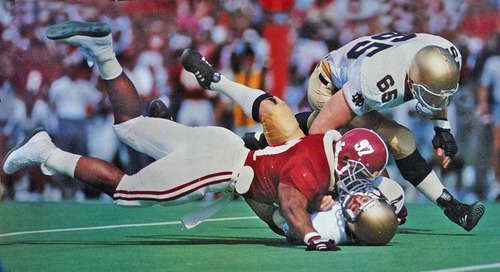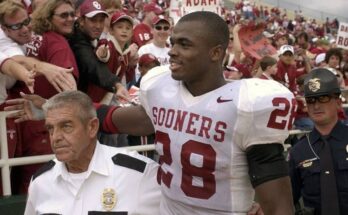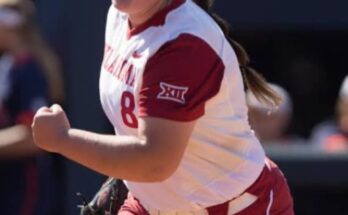The Day History Changed: Alabama’s Long-Awaited Triumph Over Notre Dame in 1986
For decades, two of college football’s most storied programs—Alabama and Notre Dame—existed in a parallel universe of dominance, tradition, and legendary figures. Yet despite Alabama’s rich heritage under the shadow of Bear Bryant and Notre Dame’s iconic status built by coaches like Knute Rockne and Ara Parseghian, one curious imbalance remained: Alabama had never defeated Notre Dame in football. Each meeting between the Crimson Tide and the Fighting Irish prior to 1986 ended in disappointment for Alabama fans, often shrouded in heartbreak or controversial outcomes. The 1986 meeting between the two titans, then, was far more than a non-conference clash; it was a date with history. When Alabama finally triumphed over Notre Dame on November 15, 1986, it was not just a victory—it was a turning point in the emotional and psychological ledger of the Crimson Tide’s football legacy.
To understand the magnitude of the 1986 victory, one must first grasp the depth of frustration that Alabama carried into every matchup against Notre Dame. The rivalry, though infrequent, was intensely personal for Alabama fans. Notre Dame had defeated Alabama in the 1973 Sugar Bowl—a game that many Crimson Tide supporters felt was theirs until late-game heroics by the Irish turned the tide. It was a game that denied Bear Bryant another national title, and the emotional scars lingered. Over the next decade, Notre Dame would go on to beat Alabama three more times in the only matchups between the two schools. By the time 1986 arrived, Alabama’s record against Notre Dame stood at 0-4. It was an embarrassing blemish on an otherwise proud resume.
The 1986 season for Alabama, under head coach Ray Perkins, was one of cautious optimism. Perkins had the unenviable task of replacing the legendary Bear Bryant, who retired after the 1982 season and passed away shortly thereafter. Perkins, a former Alabama star and an NFL head coach with the New York Giants, brought a professional style to the program but had not yet fully captured the hearts of the Alabama faithful. His record was solid but not spectacular, and the pressure to deliver a signature win was immense. On the other hand, Notre Dame was struggling under the leadership of Lou Holtz, who was in his first season trying to resurrect the Irish after years of inconsistency. Despite their 4-5 record heading into the Alabama game, the Fighting Irish were not to be taken lightly. They were dangerous, talented, and still carried the weight of history with them.
The stage was set at Legion Field in Birmingham, a venue that had long been a fortress for Alabama football. The November air was crisp, and the sense of anticipation was palpable. Fans knew this was not just another game—it was a chance to right a historical wrong, to exorcise demons that had haunted Alabama for over a decade. Alabama came into the game with a 7-2 record and ranked No. 17 in the nation. Notre Dame, though unranked, still commanded attention and respect.
From the outset, it was clear that this would not be a typical Alabama-Notre Dame contest. The Crimson Tide came out aggressive and physical, determined to control the line of scrimmage and set the tone. Alabama’s offense was methodical, led by quarterback Mike Shula—yes, the son of legendary NFL coach Don Shula—who managed the game with poise and precision. The running attack, spearheaded by Bobby Humphrey, was relentless. Humphrey’s explosive runs wore down the Notre Dame defense and opened up opportunities in the passing game.
Defensively, Alabama was a wall. The unit, coordinated by Joe Kines, was disciplined and swarming, neutralizing Notre Dame’s offense and forcing turnovers at critical moments. The defense’s intensity mirrored the crowd’s passion, as each stop and each big hit was met with a roar of approval. Notre Dame attempted to rally, but every time they seemed to gain momentum, Alabama responded with a critical play.
Perhaps the most emblematic moment of the game came late in the second half, when Alabama’s defense forced a key turnover deep in their own territory. The fumble recovery didn’t just halt a Notre Dame drive; it symbolized a broader shift—the tide, quite literally, was turning. Shula orchestrated a long, clock-consuming drive capped by a short touchdown run from Humphrey, pushing Alabama’s lead to two scores. It was the kind of commanding possession that defined great teams and sealed memorable victories.
When the final whistle blew, the scoreboard read Alabama 28, Notre Dame 10. The stadium erupted. Players hoisted each other in the air, fans cheered with unrestrained joy, and a wave of catharsis swept through Birmingham and the entire state of Alabama. The long nightmare was over. The Crimson Tide had finally defeated Notre Dame, and in doing so, had reclaimed a piece of their identity that had felt incomplete for years.
This victory meant more than just a single win on the schedule. It was symbolic. Alabama’s inability to beat Notre Dame had often been used as a point of mockery by rival fanbases and as a psychological hurdle for the program. With the win, the narrative changed. No longer would Alabama be the powerhouse that “couldn’t beat Notre Dame.” The psychological weight was lifted, and a new generation of Alabama fans could finally say they had seen their team conquer the one opponent that had always eluded them.
For Ray Perkins, the win was vindication. Though his tenure at Alabama would ultimately be brief and somewhat tumultuous, the 1986 victory over Notre Dame would stand as the crowning achievement of his time in Tuscaloosa. It was a win that even Bear Bryant, watching from above, would have appreciated. Perkins had done what Bryant himself could not—defeat Notre Dame on the field of play. In the annals of Alabama football history, that fact alone ensures his place in Crimson Tide lore.
Bobby Humphrey, too, solidified his status as one of Alabama’s all-time greats with his performance. His ability to break tackles, find seams, and push through defenders made him the engine of Alabama’s offense that day. His name, already respected, became legendary. For Mike Shula, the victory was a validation of his growth as a quarterback. Though not the most physically gifted, his calm demeanor and football IQ were exactly what Alabama needed in a high-pressure game.
Beyond individual accolades, the 1986 win helped reestablish Alabama as a national contender. It wasn’t a national title, but it was a national statement. Recruits took notice. Fans took heart. And opposing teams understood that Alabama, even in the post-Bryant era, was still capable of greatness. The program’s cultural heartbeat was still strong, still proud, and still capable of rewriting narratives.
In retrospect, the 1986 victory over Notre Dame stands as one of the most emotionally significant wins in Alabama football history. It did not end in a championship, nor did it occur in a bowl game or on a national stage. But in the hearts of Alabama fans, it was a moment as important as any title. It was about closure. About justice. About pride. It showed that perseverance pays off, that ghosts can be vanquished, and that history, while stubborn, is not immutable.
That day in Birmingham remains etched in the memories of those who witnessed it—not just for the score, but for the feeling. The feeling of redemption. The feeling of history being altered in real time. Alabama had finally slain its dragon, and in doing so, opened the door for a new chapter in its storied saga. The 1986 team may not be the most celebrated in Crimson Tide history, but on that November afternoon, they gave Alabama something it had never had before: a win over Notre Dame.
It was the day history changed. And for Alabama fans, it was worth the wait.



